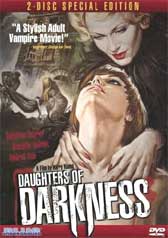 DAUGHTERS
OF DARKNESS (1971)/THE BLOOD SPATTERED BRIDE
(1972)
DAUGHTERS
OF DARKNESS (1971)/THE BLOOD SPATTERED BRIDE
(1972)One of a handful early of
early 1970s films dealing with the true-life exploits of Countess Elisabeth
Bathory (Peter Sasdy's COUNTESS DRACULA and Jorge Grau's THE FEMALE BUTCHER
being other prime examples), DAUGHTERS OF DARKNESS is a Belgium production directed
by film teacher Harry Kümel, and his only one shot in English. This is
actually the third time the film has appeared on U.S. DVD, and Blue Underground's
latest 2-disc edition is definitely a big improvement over the previous 2003
release.
Young Valerie and Stefan (Canadian-born actress Danielle Ouimet and John Karlen of "Dark Shadows" and "Cagney & Lacey" fame) are a honeymooning couple staying at a seaside hotel during the off season. It is there that they encounter the Hungarian Countess Bathory (Delphine Seyrig) and her companion Ilona (beautiful Andrea Rau) who become the only other visitors to the hotel. The Countess tells the couple of her ancestor's blood-soaked activities, but she is actually the perpetuator in question, living on through the ages and retaining a youthful appearance. The Countess becomes passionately obsessed with Valerie, and slowly woos her away from her husband who in turn is seduced by Ilona. The couple appears unstable to begin with, but having a third party interfering with their relationship leads to accidental death, followed by further deviance and doomed sexual ecstasy.
 Kümel's
dreamlike erotic vampire film is an alluring piece of art with a slight camp
edge to it. Not as bizarre as Jean Rollin's vampiric indulgences, and not nearly
as commercial as the Hammer films of the period, its atypical style is nonetheless
triumphant. Seyrig's smiling but fangless baroness is played to perfection,
looking like a 1930s movie queen, and quite credible as being immortal. The
acting and dialog is sharp throughout, as Kümel lets the film focus on
four main quirky characters, with several outside eccentrics frequently lending
to the scheme of things. The Hotel Astoria in Brussels provides a landscape
of isolation and death, and the camerawork is remarkable throughout. Not the
traditional lesbian vampire movie in the over-exploitive sense, the film still
has enough nudity and sexual tension to classify it as such. Slowly paced and
thinly plotted, this one is not for gorehounds, but it does boast three of the
most unique death scenes on celluloid, all laced with comic book violence.
Kümel's
dreamlike erotic vampire film is an alluring piece of art with a slight camp
edge to it. Not as bizarre as Jean Rollin's vampiric indulgences, and not nearly
as commercial as the Hammer films of the period, its atypical style is nonetheless
triumphant. Seyrig's smiling but fangless baroness is played to perfection,
looking like a 1930s movie queen, and quite credible as being immortal. The
acting and dialog is sharp throughout, as Kümel lets the film focus on
four main quirky characters, with several outside eccentrics frequently lending
to the scheme of things. The Hotel Astoria in Brussels provides a landscape
of isolation and death, and the camerawork is remarkable throughout. Not the
traditional lesbian vampire movie in the over-exploitive sense, the film still
has enough nudity and sexual tension to classify it as such. Slowly paced and
thinly plotted, this one is not for gorehounds, but it does boast three of the
most unique death scenes on celluloid, all laced with comic book violence.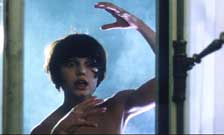
As stated before, DAUGHTERS OF DARKNESS was previously available as a DVD release from Anchor Bay, and then Blue Underground issued it again in 2003 with a new High Definition transfer. For this disc, an entirely new source material has been used, and the film looks far better than it did before. The 1.66:1 anamorphic widescreen image is noticeably cleaner, with much better definition and bold colors. Excessive grain had been a problem with the previous transfers, but that has been pretty much eliminated here, and darker scenes that were once too dark are now much easier to make out and have improved detail. There might be a few slight imperfections, but this is the best it's looked on home video. The Dolby Digital mono track (in the original English language) is satisfactory and works fine for this film.
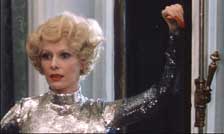 Blue
Underground includes a number of nice extras, some which are new, and some which
are recycled from the previous two editions. There’s a commentary (originally
recorded for the 2003 BU release) with director Kümel, moderated by David
Gregory. Kümel has a great memory for details, analyzing some of the better
shots in the film and discussing the locations and working with the actors,
and his true love of cinema is evident. A second audio commentary track has
star Karlen and writer David Del Valle. This commentary was originally recorded
for the Roan laserdisc, and was then included on the Anchor Bay DVD as well.
If you haven't heard this track yet, it's well worth a listen, being entertaining
and full of the good-humored actor's great reminisces about making the film.
Blue
Underground includes a number of nice extras, some which are new, and some which
are recycled from the previous two editions. There’s a commentary (originally
recorded for the 2003 BU release) with director Kümel, moderated by David
Gregory. Kümel has a great memory for details, analyzing some of the better
shots in the film and discussing the locations and working with the actors,
and his true love of cinema is evident. A second audio commentary track has
star Karlen and writer David Del Valle. This commentary was originally recorded
for the Roan laserdisc, and was then included on the Anchor Bay DVD as well.
If you haven't heard this track yet, it's well worth a listen, being entertaining
and full of the good-humored actor's great reminisces about making the film.
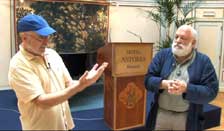
The first two featurettes here are new. “Locations of Darkness” (20 minutes) contains interviews with Harry Kümel and co-writer/producer Pierre Drouot. Both gentlemen re-visit the two main hotel locations (together they double for one hotel in the film) where a bulk of DAUGHTERS was shot, as they reminisce about specific scenes, how the film came together, and their mutual admiration for lead actress Seyrig. “Playing the Victim” (15 minutes) is an interview with star Danielle Ouimet, as she gleefully talks about her experiences making DAUGHTERS, including her working relationship with Kümel and the other players. Quimet also exclaims that she loves the film and thinks it’s the best of the 13 she appeared in. A pick-up from the 2003 BU disc is an 8-minute video interview with star Andrea Rau. The German actress speaks in her native tongue (with English subtitles of course) and discusses her early days as a model, acting in DAUGHTERS, and her working relationship with Kümel and Seyrig, as well as what she's been up to in the years since making it. There is also an impressive poster and still gallery, an American theatrical trailer, and four different American radio spots that make the film sound like a AIP/drive-in-type release!
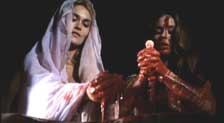 A
second disc contains the Spanish-horror opus THE BLOOD SPATTERED BRIDE, another
erotically charged effort based on J. Sheridan Le Fanu's vampire novella, Carmilla.
A young man (Simón Andreu) goes on a honeymoon with his even younger
wife Susan (Maribel Martin). After the girl fantasizes about being raped, she
begs her husband to leave the hotel that they're staying at. They wind up at
the castle of her husband's family, the Karsteins (sic) that is. Susan then
has further hallucinations about a mysterious bride, Mircalla (Alexandro Bastedo)
who later ends up as a guest at the castle. Mircalla completely absorbs the
naive girl's well being, showing a deep hatred for men, and hence inaugurating
a spree of bloodshed.
A
second disc contains the Spanish-horror opus THE BLOOD SPATTERED BRIDE, another
erotically charged effort based on J. Sheridan Le Fanu's vampire novella, Carmilla.
A young man (Simón Andreu) goes on a honeymoon with his even younger
wife Susan (Maribel Martin). After the girl fantasizes about being raped, she
begs her husband to leave the hotel that they're staying at. They wind up at
the castle of her husband's family, the Karsteins (sic) that is. Susan then
has further hallucinations about a mysterious bride, Mircalla (Alexandro Bastedo)
who later ends up as a guest at the castle. Mircalla completely absorbs the
naive girl's well being, showing a deep hatred for men, and hence inaugurating
a spree of bloodshed.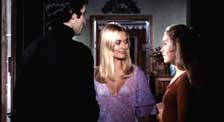
Like DAUGHTERS OF DARKNESS and Jean Rollin's erotic vampire thrillers of the same period, Vincent Aranda’s BLOOD SPATTERED BRIDE contains nudity and gore amidst the usual gothic European surroundings. However, this film does not wallow in endless softcore lesbian lovemaking scenes, but rather exploits the kinship between the two female antagonists with stylized class. The nudity is limited; Maribel Martin -- star of other vital Spanish horror romps like THE HOUSE THAT SCREAMED (1969) and A BELL FROM HELL (1973) -- was still a teenager when this was made and her skin scenes are obviously performed by a double. British actress Bastedo (she was in Freddie Francis’ THE GHOUL), who actually does disrobe, is stunning as the blonde bloodsucker, strolling about in low cut gowns.
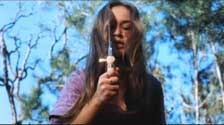 Although
sluggish in pacing, the film still succeeds and is a favorite amongst Euro horror
buffs. Most of the meat is in the third act, but the discovery of the vampire
Mircalla -- buried in the beach sand, breathing through a snorkel and having
her bare breasts dug out -- is unforgettable. A dream sequence where a man has
his heart torn out (trimmed for the original U.S. version, but fully intact
here) is also particularly nasty. The climax is also very chaotic, but an infamous,
longer, extended heart-cutting scene has been rumored about for years, and apparently
doesn't exist at all. Like in the U.S. prints, this business is accented by
an insert shot of a newspaper with a headline describing the ghastly incident.
Although
sluggish in pacing, the film still succeeds and is a favorite amongst Euro horror
buffs. Most of the meat is in the third act, but the discovery of the vampire
Mircalla -- buried in the beach sand, breathing through a snorkel and having
her bare breasts dug out -- is unforgettable. A dream sequence where a man has
his heart torn out (trimmed for the original U.S. version, but fully intact
here) is also particularly nasty. The climax is also very chaotic, but an infamous,
longer, extended heart-cutting scene has been rumored about for years, and apparently
doesn't exist at all. Like in the U.S. prints, this business is accented by
an insert shot of a newspaper with a headline describing the ghastly incident.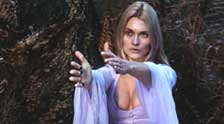
Blue Underground’s disc is identical to Anchor Bay’s previous release, right down to the menu and chapter stops. It runs 101 minutes, roughly 20 minutes longer than the U.S. version that most of us had witnesssed when MPI/Gorgon released it on video in the 1980s. The extra time is allotted for the aforementioned gore and nudity, as well as some significant character development. The film is presented in its original 1.85:1 aspect ratio with anamorphic enhancement. Colors are stable, and the transfer is very clean and blemish-free for the most part. Detail is not always the sharpest and is drowned out a bit in darker scenes on occasion. Overall, the transfer is satisfying and makes for pleasurable viewing. The English language track is mono, and sounds absolutely fine.
The only extras is an amusing
U.S. trailer promoting BRIDE's double-bill pairing with I DISMEMBER MAMA. In
1974 (when this was released here), showmanship in the cinema was still alive,
and the trailer depicts moviegoers outside the theater, being interviewed by
a typical TV news reporter. One nut is escorted out by the police while making
obscene noises to the camera. A longer version of the trailer appears on Synapse’s
first 42ND STREET FOREVER disc. (George
R. Reis)